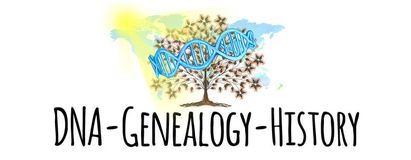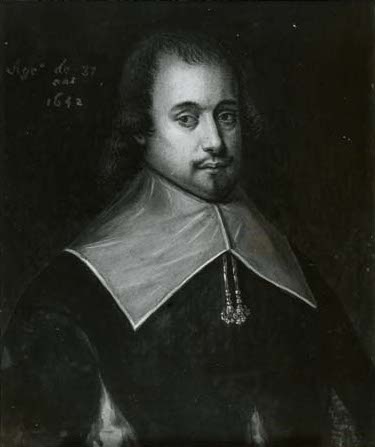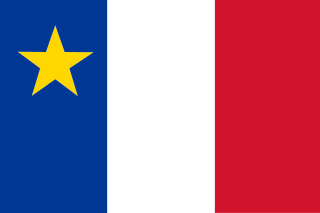|
A Portrait of the Family of Germain Doucet Sieur de Laverdure of France and the 1649 Will of Sieur Charles de Menou d’Aulnay by Deadra Doucet Bourke and Marie Rundquist October 2023 Recently, Deadra Doucet Bourke and I had the occasion to review a number of documents which had been sent to the Acadian Amerindian Ancestry Project by a long-time member. One in particular, originally written in 2019, in draft form, and later updated, concerned the Will of Sieur Charles de Menou d’Aulnay. Named in d’Aulnay’s Will, which was recorded in 1649, was his close friend, Germain Doucet Sieur de Laverdure of France, b. 1595, the military commander of the French fort at Port Royal during Acadia’s earliest days. In his Will, Sieur Charles de Menou d’Aulnay expressed his greatest admiration and generosity towards his true and loyal friend, Germain Doucet of France. By also portraying his family members and their relationships as he did in his Will, d’Aulnay, in a way, framed a “portrait” of the family of Germain Doucet as known to him at the time. Who might d’Aulnay have included when he framed his portrait of the family of Germain Doucet Sieur de Laverdure of France in his Will? But more importantly, who was left out? Referencing the Acadian Amerindian Ancestry DNA Project’s original 2008 finding of a Native American Y DNA haplogroup (C-P39) for a man who traced his patrilineal line to Germain Doucet b. 1641, and the test results of other Doucet men who shared the same ancestor, who were found to belong to the same Native American Y DNA haplogroup, we may exclude Germain Doucet b. 1641 from being the biological son of Germain Doucet of France, or, for that matter, the biological brother of Pierre Doucet b. 1621.
While the DNA results we have in the Acadian Amerindian Ancestry DNA Project help us identify and categorize the different Native American and European Doucet surname lineages represented, as stewards of our heritage, we want to find out more about the “how” and “why” behind these DNA findings and their implications for the family of Germain Doucet Sieur de Laverdure of France. And so, to add to the body of DNA evidence we have about the family of Germain Doucet of France, we share the following information a project member sent to us, in 2019, about the Will of Germain Doucet, Sieur de Laverdure’s close friend, Sieur Charles de Menou d’Aulnay, where the author states (quoting directly from his letter): “… To further complicate the situation, there has been no documentation found to date that even suggests that “Germain Doucet, Sieur de Laverdure” had children of his own. So, in summary, where we find Germain, his wife, a niece, and a nephew clearly identified by d’Aulnay in his Will, which he signed in 1649, we do not find a "son," “Germain Doucet” b. 1641 or, for that matter, another "son," “Pierre Doucet” b. 1621. There were no references to either Doucet in d’Aulney’s Will! Were they to have been Germain’s "sons," as they were clearly in the picture at the time d'Aulnay drafted his Will, surely d’Aulnay, who expressed his great affection for Germain and his concern for the well-being of his wife, his niece, and nephew in his Will, would have made provisions for them. He did not. The DNA evidence we have gathered to-date bears out why: Germain Doucet b. 1641 could never have been the biological son of Germain Doucet of France, and likewise, Germain Doucet b. 1641 could never have been the biological brother of Pierre, born 1621. As we found when we referenced project data, The Y chromosome DNA of their patrilineal, male descendants does not match up! For now, if not at the Louvre Museum in Paris, Sieur Charles de Menou d’Aulnay’s metaphorical portrait of “The Family of Germain Doucet Sieur de Laverdure” which he "painted" so eloquently in the text of his Will in 1649, that includes his friend, Germain Doucet of France, Germain’s wife, and Germain’s niece and nephew, hangs prominently on the wall of the Acadian Amerindian Ancestry DNA Project. We plan to revisit d'Aulnay's portrait of “The Family of Germain Doucet Sieur de Laverdure” from time to time, along with the genealogies, records, and DNA results of our project members, whenever new questions about old ancestors arise. References:
To any family researcher who shouts, or has ever shouted, "I JUST FOUND [fill in the blank ancestor]" just when you thought you would NEVER FIND [fill in the blank ancestor] by reading through EVERY PAGE of a civil or parish register, I dedicate the following post:
I had the occasion to recommend a couple of reliable sources on Wikitree, which I cited while adding family profiles to that system. Happily, the feedback received in response to my recommendations, appeared to be very positive. As there is no reason why I should not share these same sources with everyone, I am publishing my recommendations along with the links to Wikitree Reliable Sources lists where they have been posted. The sources I've recommended in this post have original scanned and digitized records, and they add to the numerous scanned and digitized census reports, civil and church registers, and other records inventories made available to us so graciously by the Canadian and Nova Scotia archives, the State of Louisiana, the Diocese of Baton Rouge, and other State organizations. I can't tell you how very helpful these sources are in researching and verifying the marriage, births, and deaths of our French and Acadian ancestors and how exciting it is when the name of a beloved ancestor, or two, or three, born hundreds of years ago, "pop out" (and they do have a way of "popping out") while reading through the records, in their original form. The birth notice for ancestor Charles Gaschet de Lisle, and one for the marriage of his parents, did "pop out" (finally!) in the Les Archives nationales d'outre-mer after paging through hundreds of records. I felt elated, like I struck gold, when I found their names, and all of the details of their birth and marriage events as recorded in French, in the pages of antique civil registers. That "aha" feeling was every bit worth the time it took to read through every page! Family records appear, as recorded in the original French language, in the civil registers of Saint-Pierre, Martinique as cited below (as an aside, I find I have autosomal DNA matches in My Heritage whose families are also from Saint-Pierre, Martinique -- but to find out how we relate, exactly, is research for another day):
Moving on to the Acadians. I have added my mtDNA-proven matrilineal line, and other related ancestors, starting with me (Wikitree profile M. Asselia Rundquist) and tracing all the way back, from mother to mother, to ancestor Anne Marie Mi'kmaq in Wikitree, and have of course, included my ancestors who were exiled to the State of Maryland. While editing a profile of Angelique David, one of my direct ancestors in my matrilineal line, I referenced the AcadiansWereHere.org website where we have a county map and scanned images of the 1763 census taken in Colonial Maryland.
I invite you to research both of these recommended sources with confidence, enjoy using the reliable sources pages referenced in the post, and have a great time researching ancestry! Latest Big Y test results have come in for the Richelieu - Leger surname! Thank you to the Leger man who stepped up to participate in advanced Y DNA testing as part of the Acadian Amerindian Ancestry DNA project. Currently there are no matches for this particular Big Y DNA test result and it is unique within the Family Tree DNA database. As more Richelieu - Leger men have the Big Y DNA test, we may find that the haplogroup changes. For now we are showing the distinguishing Richelieu - Leger Big Y DNA Marker as I-BY70584. This line descends from Michel Leger (b. 1729 in Quebec) and Angelique Pinet (b. 1739 in Louisbourg). The widow Angelique Pinet settled on a property in Louisiana in 1787 with her three sons and her name, and distinction as a widow of Michel Leger, may be found on the Wall of Names in St. Martinville. Angelique Pinet descends from Anne Marie (married to the unknown Pinet and then to Rene Rimbault) through Anne Marie's son, Philippe Pinet, who was married to Catherine Hebert. Matrilineal descendants of Anne Marie, traced from mother to mother, belong to haplogroup A2f1a which is Amerindian in origin. The Richelieu - Leger surname line is genetically and genealogically separate from the La Rosette - Leger line (J-M267). View the position of the I-BY70584 branch within the haplogroup I subclade on the Y DNA haplotree. France is noted as the country origin of this particular haplogroup, based upon genealogical research. This line traces back to Etienne (Estienne) Leger b. ca 1630 in France. https://www.familytreedna.com/public/y-dna-haplotree/I;name=I-BY70584. There is one downstream branch with one member reporting origins from England. The Acadian Amerindian Ancestry DNA Project Wall of Big Y DNA Markers Advanced “Big Y” DNA testing offers members of the Acadian Amerindian Ancestry DNA project insights into their surname lines and origins like none other. Big Y DNA testing has proven to be an excellent partner for those engaged with surname studies as Big Y DNA tests pinpoint specific genetic markers, called SNPs, that are unique to individual surnames. That marker is passed from father to father to father, from an earliest-known paternal ancestor to living male descendants who carry an Acadian surname. As with the project, we are inclusive of “allied” surnames as we know that post-exile, many of our Acadian ancestors intermarried with others and their DNA has since become an integral part of our genetic legacy. Because not all descendants of Acadian and allied ancestors have had the Big Y DNA tests, and right now, our Big Y DNA test results are intermixed with other project information, our list is in no way complete, and as we find more of the Big Y DNA results in our project, and new results come in, we will continue add to the list. We hope that the “Acadian Amerindian Ancestry Project Wall of Big Y DNA Markers” will help others in completing their genealogies and as always, inspire more to have Big Y DNA tests. We want to have all of our historic Acadian and allied surnames “on the map.” Please contact project administrators if you have any questions about how to order a Big Y DNA test.
Reference: https://www.familytreedna.com/public/y-dna-haplotree/I;name=I-BY70584
Reference: https://gw.geneanet.org/katheriot?lang=en&p=frederick%20joseph&n=theriot&oc=1 To learn more about the Acadian Amerindian Ancestry DNA Project, visit: https://www.familytreedna.com/groups/acadian-amerindian/about/background The Acadian Amerindian Ancestry DNA Project announces the following addition to the The Acadian Amerindian Ancestry DNA Project Wall of Big Y DNA Markers: The LeBlanc Big Y DNA marker R-FT55255! October 12, 2020 Advanced “Big Y” DNA testing offers members of the Acadian Amerindian Ancestry DNA project insights into their surname lines and origins like none other. Big Y DNA testing has proven to be an excellent partner for those engaged with surname studies as Big Y DNA tests pinpoint specific genetic markers, called SNPs, that are unique to individual surnames. That marker is passed from father to father to father, from an earliest-known paternal ancestor to living male descendants who carry an Acadian surname. As with the project, we are inclusive of “allied” surnames as we know that post-exile, many of our Acadian ancestors intermarried with others and their DNA has since become an integral part of our genetic legacy. Because not all descendants of Acadian and allied ancestors have had the Big Y DNA tests, and right now, our Big Y DNA test results are intermixed with other project information, our list is in no way complete, and as we find more of the Big Y DNA results in our project, and new results come in, we will continue add to the list. We hope that the “Acadian Amerindian Ancestry Project Wall of Big Y DNA Markers” will help others in completing their genealogies and as always, inspire more to have Big Y DNA tests. We want to have all of our historic Acadian and allied surnames “on the map.” Please contact project administrators if you have any questions about how to order a Big Y DNA test. In early October of 2020, Acadian genealogist Paul L. LeBlanc of Louisiana, whose BIG Y DNA test from Family Tree DNA of Houston, Texas, was sponsored by the Acadian Amerindian Ancestry DNA project and members of Paul's Acadian Genealogy Groups, shared that his Big Y DNA test results had come in and that he belonged to the R-FT55255 haplogroup. Review of Paul's Big Y DNA test results revealed that he had inherited the Y DNA signature SNP, R-FT55255, which formed a NEW branch of the R-BY592 haplogroup subclade. This new haplogroup, to which Paul and one other LeBlanc man belong, is one-step-down from the R-BY592 haplogroup to which one other LeBlanc man who also traces his patrilineal lines (from father-to-father) to ancestor Daniel LeBlanc of Acadia (b. ca 1626) belongs! The R-BY592 haplogroup is in turn one step down from the R-DF63 branch. It is strongly recommended that LeBlanc men in the Acadian Amerindian Ancestry and other Family Tree DNA projects who have tested positively for the R-DF63 SNP also add the Big Y DNA test to further refine their results! Paul's Big Y DNA test results proved his LeBlanc lineage twice over: once through his meticulous genealogy research and again by way of his matching 111-marker and Big Y DNA test results. Paul's Big Y DNA test results, and those of another LeBlanc man, have now formed a brand-new branch of the Y DNA tree: R-FT55255. It cannot be said enough: Big Y DNA tests are essential for identifying the descendants of specific male ancestors. A Big Y DNA test result may reveal that a descendant is an adoptee, a product of a non-patrilineal event (NPE), or (as in Paul LeBlanc's case) the surname descendant of an ancestor born in the early 1600s! The R-FT55255 haplogroup is one-step down from the R-BY592 haplogroup, which is a branch of the L21 haplogroup. The L21 haplogroup, a subclade of the R-M269 haplogroup (also referred to as the R1b haplogroup), is "the most common Y chromosome subclade of paternal lineages in the British Isles and is also significant in France." (https://www.familytreedna.com/groups/r-l21/about/background) The L21 haplogroup, and those ancestors who belonged to it, came on the scene in Europe during the Bronze Age and proliferated in short order, relatively speaking. The position of Paul's R-FT55255 haplogroup, within the current Y DNA tree, is highlighted in the following graphic: https://www.familytreedna.com/public/y-dna-haplotree/R;name=R-FT55255. If you look one step "upstream" in the tree from Paul LeBlanc's haplogroup, you'll discover three little flags icons that depict the R-BY592 parent haplogroup's European origins. One flag represents France. The other two flags represent Northern Ireland and the United Kingdom. Acadian genealogist Paul L. LeBlanc provides the following notes about his ancestor, Daniel LeBlanc (spelling variations of Paul's surname include LeBlanc, Leblanc, and LE BLANC):
Modified Register for (1) DANIEL LE BLANC First Generation 1. (1) DANIEL LE BLANC[1,2] was born about 1626. He died 1695/1698 in Port-Royal, Acadia. Location: . 1671 Port-Royal 45a 1686 Port-Royal 60a 1693 Port-Royal 66a . In the 1671 census Daniel had 17 cattle & 26 sheep. In the 1678 census, he had 12 acres and 12 cattle. His sons (Rene, Antoine, and Pierre) were living with him [Source - S White Dictionnaire]. . LE BLANC, Daniel, came from France with his wife, according to ten depositions: five from his great-grandsons (Doc. inéd., Vol. III, pp. 42, 48, 50, 88, 117), four from his great-great-grandsons (ibid., Vol. II, p. 189; Vol. III, pp. 55, 115, 120), and one from the husband of one of his great-great-granddaughters (ibid., Vol. III, p. 54). An eleventh, from his great-grandson Honoré LeBlanc, but in which his grandson Joseph LeBlanc dit Le Maigre seems to have collaborated (ibid., Vol. II, p. 170), adds that this wife was Daniel's second, and that she and her husband had brought with them Marie LeBlanc, the daughter of Daniel's first marriage. Unfortunately, none of the eleven depositions that speak of her French origin mentions this wife's name, but Françoise Gaudet is shown to have been Daniel LeBlanc's wife by four Acadian censuses (see DGFA-1, p. 666). Father Archange Godbout proved through an analysis of various marriage dispensations in an article published in 1952 ("Daniel Leblanc," SGCF, Vol. V, pp. 4-9) that the first marriage was actually Françoise Gaudet's, and that while her daughter was indeed named Marie, she was Marie Mercier, and not Marie LeBlanc. Stephen A. White, Genealogist,Centre d'études acadiennes January 17, 2005 BIRTH: Possibly born in Martiaize, Loudon, Vienne, France Census: Rc PR 1671 45a Rc PR 1686 60a Rc PR 1693 66a . . Charles C Trahan Acadian Census 1671-1752 1671 p 4 Farmer Daniel Leblanc age 45, his wife Francoise Gaudet age 48; their 7 children: one married daughter Marie-Francoise 18, not married Jacque 20, Etienne 15, Rene 14, Andre 1, Anthoine 9, Pierre 7; 18 cattle, 26 sheep, 10 arpents. . DANIEL married[1,2] (1a) FRANCOISE GAUDET[1,2,3], daughter of (1) JEAN GAUDET Jehan and FEMALE, on 1650. FRANCOISE was born about 1623. She died before 1700 in Port-Royal, Acadia. Location: maybe from near MartIaize, Loudon, Vienne, France . GAUDET, Françoise, came from France with her husband Daniel LeBlanc, according to ten depositions: five from her great-grandsons (Doc. inéd., Vol. III, pp. 42, 48, 50, 88, 117), four from her great-great-grandsons (ibid., Vol. II, p. 189; Vol. III, pp. 55, 115, 120), and one from the husband of one of her great-great-granddaughters (ibid., Vol. III, p. 54). An eleventh, from her great-grandson Honoré LeBlanc, but in which her grandson Joseph LeBlanc dit Le Maigre seems to have collaborated (ibid., Vol. II, p. 170), adds that she was Daniel's second wife, and that she and her husband had brought with them Marie LeBlanc, the daughter of Daniel's first marriage. Father Archange Godbout proved through an analysis of various marriage dispensations in an article published in 1952 ("Daniel Leblanc," SGCF, Vol. V, pp. 4-9) that the first marriage was actually Françoise Gaudet's, and that while her daughter was indeed named Marie, she was Marie Mercier, and not Marie LeBlanc. Unfortunately, none of the eleven depositions that speak of her French origin mentions Françoise's name, but she is shown to have been Daniel LeBlanc's wife by four Acadian censuses (see DGFA-1, p. 666). Stephen A. White, Genealogist,Centre d'études acadiennes January 17, 2005 Census: Rc PR 1671 48a Rc PR 1686 60a [sic] Rc PR 1693 76a [sic] Rc PR 1698 80a [sic] . Charles C Trahan Acadian Census 1671-1752 1671 p 4 Farmer Daniel Leblanc age 45, his wife Francoise Gaudet age 48;their 7 children: one married daughter Marie-Francoise 18, not married: Jacques 20, Etienne 15, Rene 14, Andre 12, Antyhoine 9, Pierre 7; 18 cattle, 26 sheep, 10 arpents. 1686 p 4 Daniel LeBlanc 60, Francoise Godet 60; 2 guns, 6 arpents, 15 cattle, 20 sheep, 7 hogs. Appendix A - Sources 1. Stephen A White, Dictionnaire Genealogique des Familles Acadiennes 1636-1714 v1, p 666-668 Gaudet Jean (1). 2. Stephen A White, Dictionnaire Genealogique des Familles Acadiennes 1636-1714 v2, p 983-985 LeBlanc Daniel (1). 3. Stephen A White, DGFA v2, p 1173-1174 Mercier (1). Index Online References:
Research of Cajun-Acadian genealogies often reveals that a single individual may descend from the same ancestor multiple times! Intermarriage is indeed a hallmark of many Acadian-Cajun lines which have their earliest roots in Port Royal, Nova Scotia, Canada. Paul LeBlanc is no different from many of his Louisiana cousins in this respect: Paul LeBlanc has fifteen lines from Daniel, from all of his children except Etienne who went to sea never to return and Pierre whose families ended up in Quebec. He has four lines from Stepdaughter Marie Mercier. Within historically Acadian parishes, Acadian brides and grooms having the exact same surnames may be found in marriage records and this trend continues today! Notably, Paul has one LeBlanc - LeBlanc marriage in his Cajun - Acadian lines. 1. (186) VI.I.1.b SIMON-JOSEPH LE BLANC[1,2] [s/o (70) Eienne & (12e) Isabella Boudreau ] was born 16 Dec 1744 and was baptized[3] 17 Dec 1744 in St-Charles-aux-Mines Catholic Church, Grand-Pre, Acadia. He was buried[4] 14 Jul 1810 in Ascension Church, Donaldsonville, Ascension, LA. Baptism: spo Jean Baptiste LeBlanc & Marguerite Halen SIMON-JOSEPH married[5] IV.A.10.e ELIZABETH LE BLANC Isabelle[1,6], daughter of (69) IV.A.10 JOSEPH LE BLANC and (6h) ISABELLE GAUDET Elizabeth Gode, on 21 Sep 1772 in Ascension Church, Donaldsonville, Ascension, LA. ELIZABETH was born 18 Apr 1753 in Port-Royal, Acadia and was baptized 19 Apr 1753 in Port-Royal, Acadia . She was buried[7] 24 May 1815 in Ascension Church Cemetery, Donaldsonville, Ascension, LA. Appendix A - Sources 1. Stephen A White, Dictionnaire Genealogique des Families Acadiennes (2) - unpublished, v L p 606-607, ?74 Le Blanc Etienne (70). 2. Lynette Le Blanc Kleinpeter, The LeBlanc Legacy, Remembrances of thr Past, 1626-1999, p 388-389 LeBlanc Simon Joseph VI.I.1.b. 3. Diocese of Baton Rouge Catholic Church Records v 1aR, p 152 (SGA-3, 30a). 4. Diocese of Baton Rouge Catholic Church Records v 3, p 556 (ASC-4, 92). 5. Diocese of Baton Rouge Catholic Church Records, v 2 p 463-464 483 (ASC-1, 120). 6. Stephen A White, DGFA (2) - unpublished, v L p 606 Le Blanc Joseph (69). 7. DOBR v 3, p 538 (ASC-4, 121). After Katrina, Paul LeBlanc moved away from New Orleans and now makes his home in Ascension Parish, Louisiana. In fact, Paul lives across the river from where his Le Blanc - Le Blanc ancestors were married back in the late 1700s, and, like his ancestors, Paul's surname at birth was also spelled "Le Blanc." Just this year, Paul learned through research that his middle name was given as "Louis" at baptism -- and not the civil name, "Lewis," which he had used all of his life. Paul wants all to know that his only relatives in the British Isles came over in 1066 (the year of the Norman conquest of England). The Acadian Amerindian Ancestry DNA Project invites all men of Acadian lines to have the Big Y DNA test and add their Big Y DNA test results to the Acadian Amerindian Ancestry DNA Project Wall of Big Y DNA Markers. For more information about the Acadian Amerindian Ancestry DNA Project, visit: https://www.familytreedna.com/groups/acadian-amerindian/about/background |
Archives
June 2025
Categories
All
|
DNA-Genealogy-History.com Site Index:
Copyright 2025 Marie Rundquist., DNA Genealogy History, LLC
DNA Genealogy History, LLC is a registered S Corporation with the State of Virginia and the Federal Government since 2017, is a retailer and distributor of books and digital publications, and is certified, authorized and empowered to collect Sales and Use Tax for the Commonwealth of Virginia.
E-Mail Your Comments to [email protected]
This website is not intended for users located within the European Economic Area.
DNA Genealogy History, LLC is a registered S Corporation with the State of Virginia and the Federal Government since 2017, is a retailer and distributor of books and digital publications, and is certified, authorized and empowered to collect Sales and Use Tax for the Commonwealth of Virginia.
E-Mail Your Comments to [email protected]
This website is not intended for users located within the European Economic Area.









 RSS Feed
RSS Feed
